#013: Characteristics of Division Basidiomycota
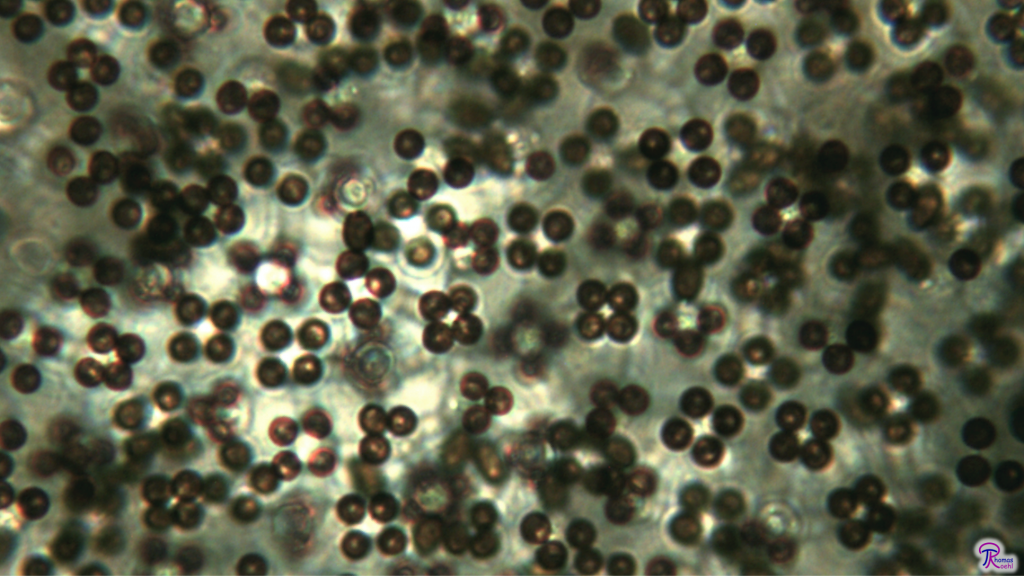
Each cluster of four spores belongs to a separate basidium. Producing multiple sexual spores externally is one of the most distinctive features of the Basidiomycota. The pictured spores are from an inky cap.
Division Basidiomycota (also called Phylum Basidiomycota) accounts for about 37% of all described fungal species. This division contains the fungi that people are most familiar with. The classic “Mario mushroom” (based on Amanita muscaria), the grocery store button mushroom and other varieties of Agaricus bisporus, shiitakes, oyster mushrooms, and even the major “magic mushrooms” are all basidiomycetes. However, the Basidiomycota also include rusts and smuts, which are economically important plant pathogens, some yeasts, and a few lichenized fungi. Like the Ascomycota, the Basidiomycota fill a variety of different ecological roles. Many form mycorrhizas with plants, others parasitize plants, a lot decompose organic material, and some live in a variety of symbioses with insects. The Basidiomycota are commonly referred to as “basidiomycetes,” “basidios,” or “club fungi.”1
Life Cycle and Morphology
The Basidiomycota are amazingly diverse organisms. They come in so many different forms that it is difficult to find any physical characteristics that define the group.1 Instead, mycologists are forced to say, “Most basidiomycetes…” or, “The Basidiomycota tend to…” and similar things. The one thing nearly all basidiomycetes have in common that differentiates them from all other fungi is the basidium.
Sexual Reproduction (2n to n)
A basidium (pl. basidia) is a specialized cell that carries out sexual reproduction. Not all basidiomycetes produce basidia because some reproduce only asexually. Basidia produce multiple sexual spores (“basidiospores”) externally on short spikes called sterigmata (sing. sterigma). This unique combination of characteristics is found only in basidiomycetes.1 Ascomycetes, for example, produce multiple sexual spores but do so internally (see FFF#012 for more).2 Most basidia produce four basidiospores, but the exact number can vary. Each basidiospore usually contains one haploid nucleus, but – surprise, surprise – that also changes based on the species.1
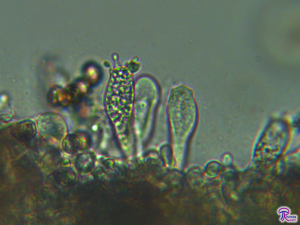
Holobasidia preparing to produce spores. The basidium in the foreground has four newly-forming spores on top of its sterigmata.
Basidia come in a variety of shapes. A vast majority of species, including most mushroom-forming species, form holobasidia. These basidia are club-shaped, do not contain any septa, and usually produce four spores.3 Thanks to holobasidia, the Basidiomycota are sometimes called the “club fungi” (note that “club fungi” can also refer to a mushroom morphological group, see FFF#038).
Cruciate septate basidia are similar in shape to unicellular basidia but produce two septa that form an x-shape when viewed from above. This creates four distinct compartments within the basidium. At the top of the basidium, each compartment produces one spore on a very long sterigma. Cruciate septate basidia are primarily made by the jelly fungi in the order Tremellales.3
Other jelly fungi in the order Auriculariales as well as some rust fungi produce a different type of basidia: transversely septate basidia. These basidia form three parallel septa to divide the cylindrical basidium into four compartments. If that is hard to visualize, imagine cutting a baguette in half and then cutting both pieces in half again; you will have made three cuts and will end up with four cylindrical baguette slices. Each compartment of a transversely septate basidium produces one spore on a sterigma that can vary in size.3
One last type of basidium exists: tuning fork basidia, also called bifurcated basidia. These basidia begin as long cylinders but branch once to form a tuning fork or Y shape. Each fork produces a single basidiospore. Tuning fork basidia are found in fungi of the order Dacrymycetales.3
Inside any basidium, two haploid nuclei – one from each of the organism’s parents (denoted n+n) – fuse and carry out meiosis. The end result of this process is four haploid nuclei (each denoted n) each containing genes from both parent nuclei. Usually, each nucleus migrates into a basidiospore. Once the basidiospores are mature, they are catapulted off the basidium through a process called ballistospory.1
Ballistospory
Ballistospory is the method basidiomycotan fungi use to forcibly discharge their spores (“ballistospores”). This process is common and widespread among the Basidiomycota and is used by everything from mushrooms to yeasts to discharge spores from basidia, hyphae, and even other ballistospors. While most basidiomycetes produce ballistospores, some have lost that ability. Species of Basidiomycota that live in the water or produce spores inside closed fruiting bodies (like puffballs, bird’s nests, stinkhorns, etc.) generally cannot form ballistospores. Ballistospory occurs in both sexual spores and asexual spores; whether you call it a ‘ballistospore,’ ‘basidiospore,’ or something else depends upon which aspect of the spore you want to emphasize.1
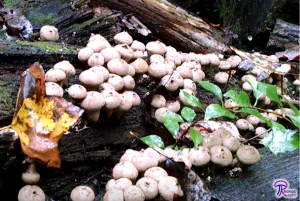
Puffballs, such as these Lycoperdon pyriforme, and other basidiomycetes whose spores develop internally have lost the ability to form ballistospores.
The physical process that allows for ballistospory is still not fully understood, but mycologists have a general idea of how it works. Near the tip of the sterigma, a small bead of liquid called the ‘hilar droplet’ forms. Once this droplet gets big enough, it touches the spore and fuses with the thin liquid layer coating the spore. As you have probably seen in a sink or on a car windshield, when two water droplets touch they seem to jump towards one another and form a larger droplet at the spot where they made contact. Essentially, the same thing happens with ballistospory. Once the hilar droplet touches the spore, the liquid jumps up and surrounds the spore. The spore can’t move toward the hilar droplet because it is still supported by the sterigma in that direction, so all the hilar droplet’s mass is transferred to the spore. This rapid transfer of mass directed away from the sterigma basically catapults the spore off of the sterigma and into the air. Two droplets of water fusing in a sink don’t seem like they are capable of producing enough force to launch something into the air, but basidiomycete spores are small enough that the “surface tension catapult” mechanism can fling them away at 25,000 times the acceleration due to gravity.1
Growth (n to n+n)
Once a basidiospore (n) lands on an appropriate substrate, it germinates and begins to grow. This process follows the generalized life cycle described in FFF#009. During this early phase of the fungus’ life cycle, it usually does not form septa so the mycelium is not divided into discernable cells. Consequently, the mycelium is basically one large cell populated by many nuclei. At this point, each nucleus is a copy of the one contained in the basidiospore. Because the nuclei are all identical, the mycelium has only one set of chromosomes and is still considered haploid (n).1
Most fungi spend the majority of their lives in the haploid state, but the Basidiomycota do things differently. Basidiomycetes generally have a very long dikaryotic stage. Upon encountering a sexually compatible fungus, the two fungi fuse and the new nucleus makes copies of itself and sends them to all parts of the mycelium. The entire mycelium now has two copies of every chromosome but they are stored in separate nuclei. This state is called dikaryotic and is designated n+n. The fungus will remain dikaryotic for the rest of its life.1
Most species in Basidiomycota have at least one “mating type” gene that determines sexual compatibility. The simplest system in basidiomycetes is roughly equivalent to male/female, but many species have multiple mating type genes, which makes things much more complicated.1 Schizophyllum commune, for example, has 28,000 possible mating type combinations (see FFF#085 for more on mating types and S. commune).
In both the haploid and dikaryotic phases of its life cycle, the fungus is capable of growing and producing asexual spores. However, it can produce sexual spores only after it becomes dikaryotic. Consequently, all mushrooms – which are sexual fruiting structures – arise from dikaryotic mycelia.1
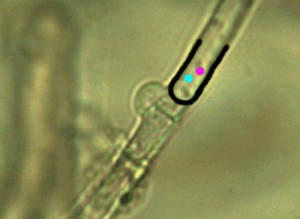
Animation showing the process of forming clamp connections. Colored dots are nuclei from different parents.
To ensure that the entire mycelium has exactly one set of genes from each parent nucleus, many basidiomycetes form complex septa and follow a rigid process of mitosis.1 Many fungi in the subdivision Agaricomycotina produce dolipore septa, which tightly regulate what passes from one cell to the next (for more on dolipore septa and other types of septa, see FFF#004).4 Basidiomycetes also sometimes produce unique structures called “clamp connections” during mitosis.1 Clamp connections look like large bumps on the outside of the hyphae and always appear over septa that divide one cell from the next. During mitosis in fungi, the dividing nucleus usually straddles the plane where the new septum will form. This way, each cell ends up with one nucleus once the septum is formed. Unfortunately, it would get too confusing for both nuclei to line up in the same spot. To solve this problem, a small branch starts to grow near where the new septum is about to form. One nucleus lines up where the septum will form and the other lines up at the entrance to the branch. Both nuclei divide and septa form at the main cell division site and at the branch entrance. Now, there are two nuclei in the new cell, one nucleus in the old cell, and one nucleus in the branch. To return the branch nucleus to the old cell, the branch simply bends over and fuses with the old cell. The branch has now become a clamp connection.5
Asexual Reproduction (xn to xn)
Asexual reproduction can happen at any time during the growth phase of the fungus’ life cycle, however it most often occurs when the fungus is haploid. Either way, the spores will have the same number of nuclei as the parent fungus. Most basidiomycotan asexual spores are produced when existing hyphae are converted into spores, but some are produced by budding off of a hyphal tip.6
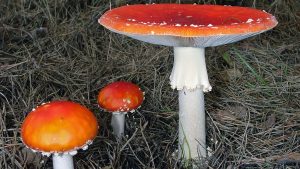
Basidiomycotan fungi fill a variety of different ecological roles. This Amanita muscaria is an ectomycorrhizal species. By Chrumps [GFDL or CC BY-SA 3.0], via Wikimedia Commons (cropped)
Ecology
Division Basidiomycota contains organisms that fit in just about every ecological category. A lot of these fungi are saprobic and decompose organic matter. These include yeasts, many forest mushrooms, and almost all the mushrooms you can find at a grocery store. Some of the most economically important basidiomycetes are actually parasitic on plants. Rusts and smuts do tremendous economic damage to crops every year and Armillaria species are some of the most efficient tree-killing fungi, much to the chagrin of foresters. Many basidiomycetes are ectomycorrhizal and form mutualistic associations with trees (see FFF#075 for more). Examples from this group include amanitas, chanterelles, and boletes, just to name a few. A surprising number of basidiomycetes are insect pathogens, but some of the Basidiomycota actually benefit termites and leaf cutter ants. There are even a few that have evolved into lichens.1
Taxonomy and Evolution
Ascomycota and Basidiomycota share a common ancestor and together make up the monophyletic subkingdom Dikarya.7,8 This is hardly surprising; the two divisions have very similar life cycles, cellular morphologies, and ecologies. These divisions evolved most recently and are generally more complex than fungi from other divisions. Within the Basidiomycota, there are three major subdivisions: Agaricomycotina, which contains most of the mushroom-forming species, Pucciniomycotina, which contains the rusts and relatives, and Ustilaginomycotina, which contains the smuts and relatives. Mycologists have been unable to determine the proper placement for two classes (Wallemiomycets and Entorrhizomycetes) that do not fit into any of those groups.1,7
| Kingdom | Fungi |
| Division (Phylum) | Basidiomycota Whittaker ex Moore9 |
| Subdivision (Subphylum) | Agaricomycotina1 |
| Pucciniomycotina1 | |
| Ustilaginomycotina1 | |
| ? (Class Wallemiomycetes)1 | |
| ? (Class Entorrhizomycetes)1 |
See Further:
http://tolweb.org/Basidiomycota
http://archive.bio.ed.ac.uk/jdeacon/microbes/basidio.htm
http://bugs.bio.usyd.edu.au/learning/resources/Mycology/Taxonomy/basidiomycota.shtml
Citations
- Swann, E. & Hibbett, D. S. Basidiomycota. The Club Fungi. Tree of Life Web Project (2007). Available at: http://tolweb.org/Basidiomycota. (Accessed: 6th July 2017)
- Taylor, J. W., Spatafora, J. & Berbee, M. Ascomycota. Sac Fungi. Tree of Life Web Project (2006). Available at: http://tolweb.org/Ascomycota/20521. (Accessed: 7th July 2017)
- Volk, T. J. Tom Volk’s Fungus of the Month for April 2004. Tom Volk’s Fungi (2004). Available at: http://botit.botany.wisc.edu/toms_fungi/apr2004.html. (Accessed: 7th July 2017)
- Hibbett, D. S. Agaricomycotina. Jelly Fungi, Yeasts, and Mushrooms. Tree of Life Web Project (2007). Available at: http://tolweb.org/Agaricomycotina/20531. (Accessed: 7th July 2017)
- Deacon, J. Basidiomycota: activities and lifestyle. The Microbial World Available at: http://archive.bio.ed.ac.uk/jdeacon/microbes/basidio.htm. (Accessed: 7th July 2017)
- Division Basidiomycota. Fungal Biology (2004). Available at: http://bugs.bio.usyd.edu.au/learning/resources/Mycology/Taxonomy/basidiomycota.shtml. (Accessed: 7th July 2017)
- Lutzoni, F. et al. Assembling the fungal tree of life: progress, classification, and evolution of subcellular traits. Am. J. Bot. 91, 1446–1480 (2004).
- Dikarya. Wikipedia (2017).
- Basidiomycota. Mycobank Available at: http://www.mycobank.org/Biolomics.aspx?Table=Mycobank&Rec=92345&Fields=All. (Accessed: 6th July 2017)


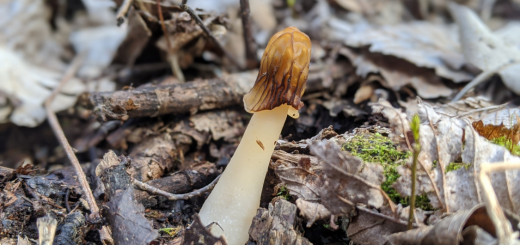





![#011: Characteristics of Kingdom Fungi [Archived]](https://www.fungusfactfriday.com/wp-content/themes/hueman/assets/front/img/thumb-small-empty.png)

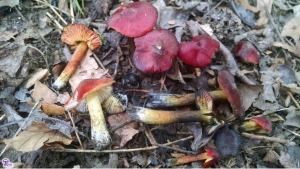
36 Responses
[…] stinkhorns are found in the phylum Basidiomycota, class Agaricomycetes, order Phallales. All fungi in this order produce a stinky spore mass, […]
[…] which belongs to the family Diplocystaceae. Both of these families are found in the phylum Basidiomycota, class Agaricomycetes, and order Boletales. The families Sclerodermataceae and Diplocystaceae are […]
[…] the puffballs) or in their own family Nidulariaceae. Both of these families are placed in phylum Basidiomycota, class Agaricomycetes, and order Agaricales. This means that their closest relatives are gilled […]
[…] sequestrate fungi* are an unnatural grouping of mushroom-forming basidiomycetes that have adapted to life in desert areas by keeping developing spores inside the fruiting body. […]
[…] Basidiomycota […]
[…] Basidiomycota […]
[…] Basidiomycota […]
[…] Basidiomycota […]
[…] Basidiomycota […]
[…] Basidiomycota […]
[…] Basidiomycota […]
[…] Basidiomycota […]
[…] Basidiomycota […]
[…] Basidiomycota […]
[…] Basidiomycota […]
[…] gills have evolved independently multiple times. Gilled mushrooms are all basidiomycetes (see FFF#013), but the morphological group is polyphyletic. At this point it is important to note that the terms […]
[…] Basidiomycota […]
[…] Basidiomycota […]
[…] Basidiomycota […]
[…] Basidiomycota […]
[…] by asci (as in earth tongue look-alikes) or by basidia (as in corals and clubs). See FFF#012 and #013 for more on asci and […]
[…] Basidiomycota […]
[…] Basidiomycota […]
[…] Basidiomycota […]
[…] Basidiomycota […]
[…] Basidiomycota […]
[…] Basidiomycota […]
[…] Basidiomycota […]
[…] Basidiomycota […]
[…] Basidiomycota […]
[…] Basidiomycota […]
[…] Basidiomycota […]
[…] Basidiomycota […]
[…] Basidiomycota […]
[…] Basidiomycota […]
[…] and then undergo meiosis to produce haploid spores. Most ascomycetes (FFF#012) and basidiomycetes (FFF#013) use this life […]